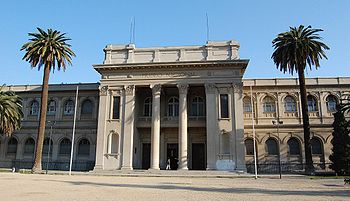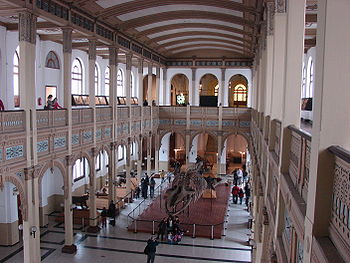- Chilean National Museum of Natural History
-
The Chilean National Museum of Natural History (Spanish: Museo Nacional de Historia Natural or MNHN) is one of three national museums in Chile, along with the Museum of Fine Arts and the National History Museum. It is located in Quinta Normal.
Contents
History
The museum is one of the oldest natural history museums in South America. It was founded on September 14, 1830 by the French naturalist Claudio Gay, commissioned by the Chilean government. Its original mandate was the biology and geography of Chile, with a concentration on crops and mineral resources.
In 1889 departments of botany, zoology, and mineralogy were established. The National Museum Bulletin (Boletín del Museo Nacional) was first published in 1908, and continues today under the title Bulletin of the National Museum of Natural History (Boletín del Museo Nacional de Historia Natural).
Earthquakes in August 1906 and April 1927 have damaged the museum.[1]
Exhibits
The central hall, with a blue whale skeleton
The museum currently has twelve permanent exhibits:
- Biogeography of Chile, a long tunnel that fills much of the first floor
- Interactive children's games for terrestrial ecosystems
- The Central Hall exhibits, including a 17-meter skeleton of a blue whale
- Minerals, with an emphasis on the nitrate boom of the early twentieth century.
- Insects, including large fossil dragonflies
- Mollusks
- Mesozoic era vertebrates, including a specimen of Carnotaurus sastrei
- Chilean timber
- Chilean archaeology
- Juan Fernández Islands
- Cultural anthropology, covering the Aymara, Mapuche, Selk'nam, Rapanui, Kaweskar, and Yámana. The museum houses the finest public collection of rongorongo artifacts in the world.
- The uses of copper, a collection of Codelco, the state mining corporation
Departments
The four departments are botany, zoology, anthropology, and paleontology.
The department of botany includes a herbarium of 3700 species dating from 1830. 90% of the type specimens of Chilean species are housed here.
The zoology department contains fourteen holotypes, mainly Chilean marine and freshwater fish.
The anthropological department emphasizes the archeology of Central Chile through the Inca Empire and cultural artifacts of modern or recently extinct peoples of Chile and Easter Island. One of its duties is the caretaking of the Plomo Mummy.
References
- ^ A flyer handed out at the museum.
External links
Coordinates: 33°26′32″S 70°40′55″W / 33.44217°S 70.68184°W
Categories:- Museums established in 1830
- Museums in Santiago Metropolitan Region
- Natural history museums
Wikimedia Foundation. 2010.


